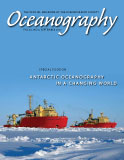Article Abstract
This article highlights recent and ongoing studies that analyze in situ underway upper ocean and surface atmospheric observations from frequently repeated transects by the Antarctic Research and Supply Vessel Laurence M. Gould in Drake Passage. High-resolution measurements of upper ocean temperature, salinity, and velocity, along with concurrent shipboard meteorological, surface water CO2, and nutrient sampling have been routinely acquired aboard the Gould since the late 1990s. There are significant benefits and synergy of air-sea observations when they are measured at similar temporal and spatial scales from the same platform. The multiyear measurements have been used to examine seasonal and spatial variability in upper ocean heat content, Antarctic Circumpolar Current transport variability, eddy heat and momentum fluxes, frontal variability, validation of satellite and model-based air-sea fluxes, and the upper ocean response to climate variability. At present, the Gould provides the only year-round shipboard air-sea measurements in the Southern Ocean. Collectively, the measurements in Drake Passage have provided much insight into the characteristics, mechanisms, and impacts of the processes and changes that are occurring within the Southern Ocean.

